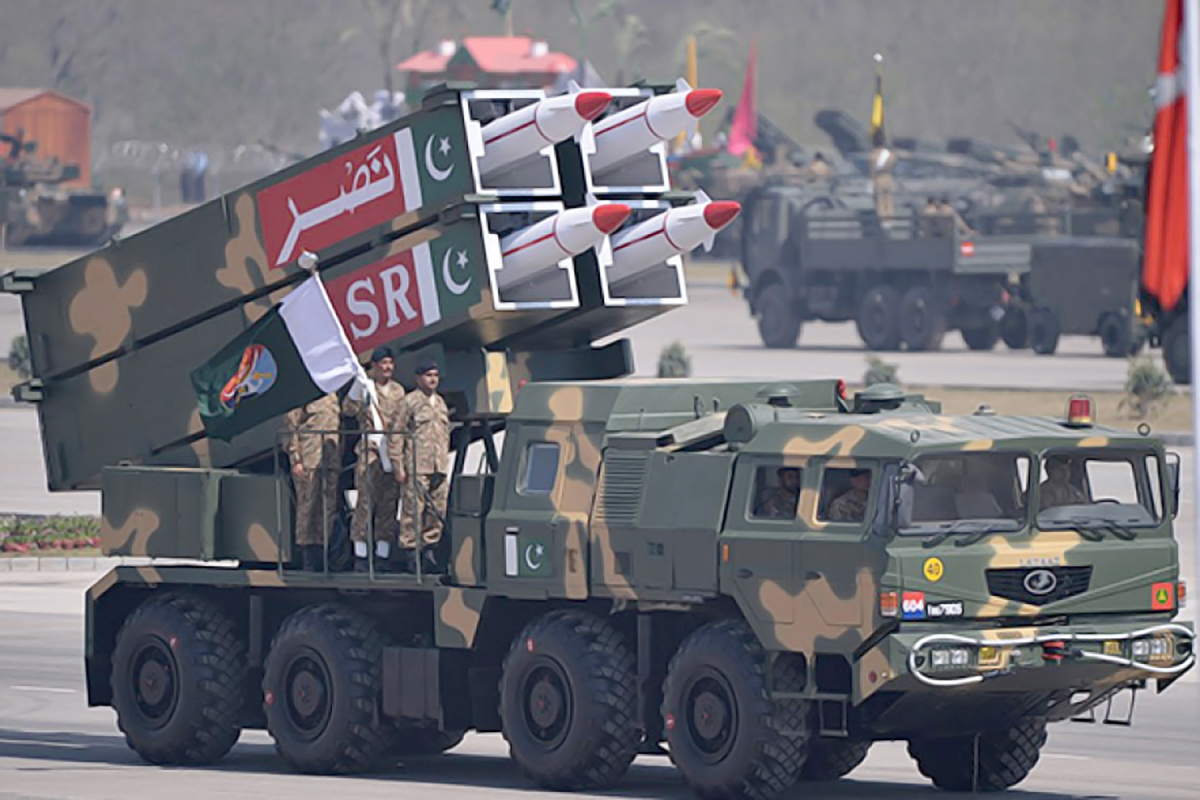By Interaction Team
Amidst the intricate landscape of geopolitics and strategic affairs, Pakistan’s Nasr Missile, produced by the National Development Complex (NDC), has become a crucial element of its Full Spectrum Deterrence (FSD) defense strategy. With its multi-tube ballistic design, sub-kiloton tactical nuclear warheads, and remarkable precision, it has garnered significant attention.
The Nasr Missile serves as a direct response to India’s Cold Start Doctrine, which involves limited offensives below Pakistan’s nuclear threshold. It thus enhances Pakistan’s nuclear as well as conventional deterrence. Additionally, its short-range and swift flight time have presented a formidable challenge to India’s Ballistic Missile Defense (BMD) system.
UNVEILING THE NASR MISSILE
The story of the Nasr Missile unfolds within the confines of the National Development Complex, where a team of brilliant scientists and engineers meticulously crafted this cutting-edge weapon system. Distinguished by its unique feature of carrying multiple missiles on a single launch vehicle, it earned the title “Multi-tube Ballistic Missile.”
In 2011, the world witnessed its first test-firing, a momentous event that significantly impacted the security dynamics in South Asia. Its subsequent testing in 2013 marked its official entry into service, solidifying its position as a formidable tactical deterrent.
The Nasr Missile, boasting a range of 70 kilometers, is renowned as a highly accurate and agile “shoot and scoot” weapon, utilizing solid fuel, and has the ability to effectively neutralize India’s ballistic missile defense.
According to Mansoor Ahmed from Quaid-e-Azam University’s Department of Defense and Strategic Studies, the Nasr Missile’s enhanced in-flight maneuverability allows it to defeat Indian missile defenses designed for artillery rockets and short-range ballistic missiles, including systems like the Israeli Iron Dome.
Nasr’s versatility made it capable to carry both conventional and nuclear warheads, though its reputation largely revolves around its potential to carry nuclear warheads of appropriate yield. Launched from a multi-tube launcher with the capability to fire four missiles, Nasr is considered a highly efficient weapon that can be quickly prepared for launch.
In fact, the development of the Nasr was a direct response to India’s furtive Cold Start doctrine (CSD), which was later on officially confirmed by Indian Army Chief Gen. Bipin Rawat. As a tactical nuclear weapon system, the Nasr is intended to prevent India from engaging in conventional conflict below the nuclear threshold.
THE COLD START DOCTRINE AND PAKISTAN’S RESPONSE
To understand the significance of the Nasr Missile, it is essential to consider the strategic context that led to its development. In the beginning of 2000s, India designed a limited war strategy with the name of ‘Cold Start Doctrine’ to seize Pakistani territory swiftly without, in theory, risking a nuclear conflict.
It however, raised security concerns for Pakistan and in response, Pakistan had to develop the Nasr Missile as a “low-yield battlefield deterrent”. The approach intended to add deterrence value and ensure a quick response in shorter ranges, countering India’s aggressive ambitions.
Advisor NCA (National Command Authority), Lieutenant General (R) Khalid Ahmed Kidwai, explaining the purpose of Nasr missile, stated that the successful test of Nasr was intended to dampen India’s Cold Start Doctrine. According to him, Pakistan’s nuclear weapons would only be used if the very existence of the country was at risk, with the sole aim of deterring Indian aggression.
Kidwai also highlighted that India’s CSD is an offensive limited war strategy meant to swiftly seize Pakistan’s territory, and the development of Tactical Nuclear Weapons (TNWs) has effectively blocked avenues for serious military operations from the Indian side.
ADVANCEMENTS IN NASR MISSILE PROGRAM AND ITS UNIQUE ROLE AS A TACTICAL NUCLEAR WEAPON
The Nasr Missile program in Pakistan has made significant advancements and achieved new technical parameters through continuous training launches and tests. The recent improvements, including an extended maximum range of 70 kilometers and enhanced flight maneuverability, have strengthened the Nasr Missile’s efficacy as a deterrent against various threats, potentially reshaping the security dynamics of the region.
The missile’s journey began with its first flight test in April 2011, followed by several subsequent tests, culminating in a powerful display of its capabilities in a test conducted in January 2019. The Nasr Missile, featuring a blast yield of 0.5-5 kilotons, can counter sophisticated missile defense systems. This capability makes it a crucial asset in deterring Indian armored thrusts into Pakistani territory.
The test footage of the Nasr, released by Inter Services Public Relations (ISPR) Pakistan in January 2019, demonstrates its exceptional precision in hitting targets, showcasing its potential as a highly effective tactical weapon.
NASR’S INTEGRATION AND COMMAND STRUCTURE
The Nasr Missile has been seamlessly integrated into Pakistan’s centralized command-and-control structure, granting decision-makers at the National Command Authority (NCA) prompt situational awareness for swift and effective responses to potential threats.
This integration highlights the Nasr Missile’s vital role in Pakistan’s FSD. Pakistan’s strategy involving tactical nuclear weapons is evident in its objective to limit destruction and avoid provoking large-scale Indian retaliation.
In an interview with The Washington Post, Aizaz Chaudhry, the former Pakistani foreign secretary, clarified that India’s adoption of the Cold Start Doctrine has created an imbalance in the military capabilities of the two nations. Consequently, Pakistan felt compelled to develop short-range nuclear weapons as a response to address this situation..
CONCLUSION
In conclusion, the Nasr Missile stands as a remarkable achievement, showcasing Pakistan’s scientific prowess and strategic foresight. Its emergence as a critical tactical ballistic deterrent against India’s Cold Start Doctrine highlights Pakistan’s unwavering commitment to national security.


